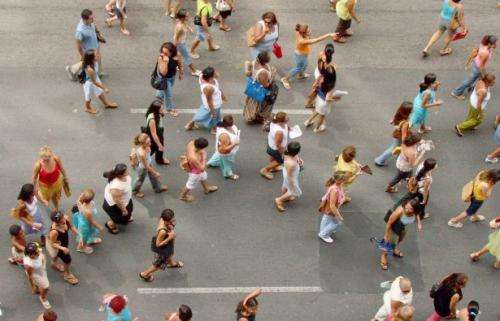How new social movements take root

Contemporary movements, such as those initiated after the recent shooting death of Michael Brown in Ferguson, Mo., can be born seemingly overnight in the digital age. UA researchers point to several factors.
After the shooting death of Michael Brown in Ferguson, Mo., #BlackLifeMatters—first used after the shooting death of Trayvon Martin—re-emerged in popular media and social media platforms, reigniting national conversations about policing practices, particularly in African-American communities.
Much like campaigns such as #YesAllWomen, #OccupyWallStreet, #BringBackOurGirls and #AllMenCan, the handle also has been used to animate community-based action, political debate and state agency response. The same can be said of #BlackLivesMatter, which has led to the organization of initiatives and protests similar to those of the Freedom Riders in the 1960s.
At a minimum, such campaigns have helped to get people talking about societal ills. In some cases, they have led to social reforms and policy shifts, suggesting that the role of technology and social media is revolutionizing contemporary movements, said Susan Shaw, an associate professor in the UA School of Anthropology.
Such initiatives indicate major changes in the ways that social movements form and evolve, said Shaw, who is among UA social scientists working to advance understanding about new movements.
UA sociologist Monica Casper, head of the UA's Department of Gender and Women's Studies, is teaching an honors course this semester on racial inequality and social justice in the wake of #BlackLifeMatters and the Ferguson case. Casper also has helped organize several campus events leading up to the "Black Life Matters Conference" to be held at the UA in January.
"There were several aspects of the Ferguson case that outraged people, including the fact that white police shot an unarmed black teenager and left his body in the street for hours. There was no apology, no accountability," Casper said.
"In the U.S., we are not even close to being 'post-racial,' and white supremacy runs deep in our institutions, histories, cultural memory and pop culture," Casper said of the need to understand activism represented by #BlackLifeMatters.
The birth of social movements
Casper, Shaw and other social scientists at the UA note at least three significant phenomena associated with new social movements:
- Single-issue movements appear to be in decline, with evidence for unification around cross-issue organizing.
- Many new movements appear to launch after multiple grievances—especially in various parts of the nation —become evident in the larger public sphere.
- The use of technology is aiding movement development, growth and sustainability.
For example, #BlackLifeMatters began in a smaller social circle. It is not only tied to cases sharing similar consequences—the shooting deaths of Kimani Gray in New York, Renisha McBride in Michigan and Martin in Florida—but it also evoked issues related to law enforcement policies, policing practices, black popular culture, media representation and the betterment of the African-American community.
"Brown's death, layered on top of the earlier tragedies, generated a national conversation, an outpouring of grief and a movement," Casper said.

Two schools of thought exist on how social movements are born and sustained. One holds that people organize around grievances. The other holds that grievances require a "political opportunity," an availability of resources necessary for organizing: time, money, space and access to media representatives.
Above all, social movements usually are established around issues of political and social equity, Casper said.
"Social movements are typically born out of some deep, shared concern and need to make change, and while they are often organized on behalf of social justice, they may also congeal around shared values, as in the anti-abortion movement," Casper said. "They often attract people who may be marginalized vis-à-vis the dominant society or group."
Shaw and Casper noted that a significant boon to launching new social movements has come through technology, specifically social media platforms with their immediacy and massive international networks.
"Movements need direction, communication, and shared vision—something that has become quite easy to provide in our digital age, where social media has both ignited and enabled various movements," Casper said.
The Arab Spring protests that began at the end of 2010 are a significant example, having taken the international stage sparked by social media. In fact, social media interactions, especially those on Facebook, are credited with regime changes in the Arab world, Shaw said.
"With social media platforms, people can communicate outside of official challenges that are not monitored and, of course, have the capacity to reach mass audiences," Shaw said. "It also helps people who are facing stiff government resistance to find a way to communicate, gather and organize."
National shifts in policing practices
The period spanning the 1960s and '80s resulted in significant changes in policing policies related to protests, said Jennifer Earl, a UA sociology professor and an expert on social movements and movement repression.
Earl, recently funded with a National Science Foundation grant to study U.S. policing practices dating back to the '60s, said the '70s marked a move in policing from a repression model to a "negotiated management" approach.
The negotiation approach, the prevailing model by the late '70s, is designed to reduce force and decrease protest intensity, Earl said. Agencies have done this by implementing permit requirements and negotiating with protesters about the time, place and manner of protest, she said.
Since the '90s, however, the nation has seen a rise in "police militarization," a move to arm officers with tactics and weapons normally reserved for warfare. The negotiated management model has been irregularly implemented, Earl said.
"You can see, in situations like Ferguson, that even when you have models of practice that departments and chiefs of police agree on, that doesn't mean they are always implemented," she said. "So, in Ferguson, it was like watching different scripts for police action from the 1960s to the mid-1970s play out in fast forward."
The public response since Brown's death has aligned with what Casper and Shaw noted about new social movements.
"Ferguson did create some real public awareness about police militarization, and this is causing some pushback," Earl said. "Now some cities are saying, 'We don't want and we don't need these tools in our communities.' But where it will settle is hard to tell."
The country has not seen such a significant change in police policies since the '80s, Earl said, adding that post-9/11 concerns have had an effect.
"There are a lot of competing models for how police should handle protests, but a singular model that enjoys wide consistence in the law enforcement field? We are not there yet," Earl said. "We are still in that innovation process, and the best practices have not yet emerged. Police are still struggling with their responsibility to protect and also support protesters' rights."
Evidence of a change in organizing and action had been present for a while.
"It was in the late 1990s with the World Trade Organization protests in Seattle that we began to see all manners of concerns addressed—labor, environment, class issues, anti-poverty," Shaw said.
"That was the first time we saw that, and I suspect we will see more of that as people become increasingly aware that many issues are interconnected and simultaneously demand attention to multiple points of view."
Provided by University of Arizona


















